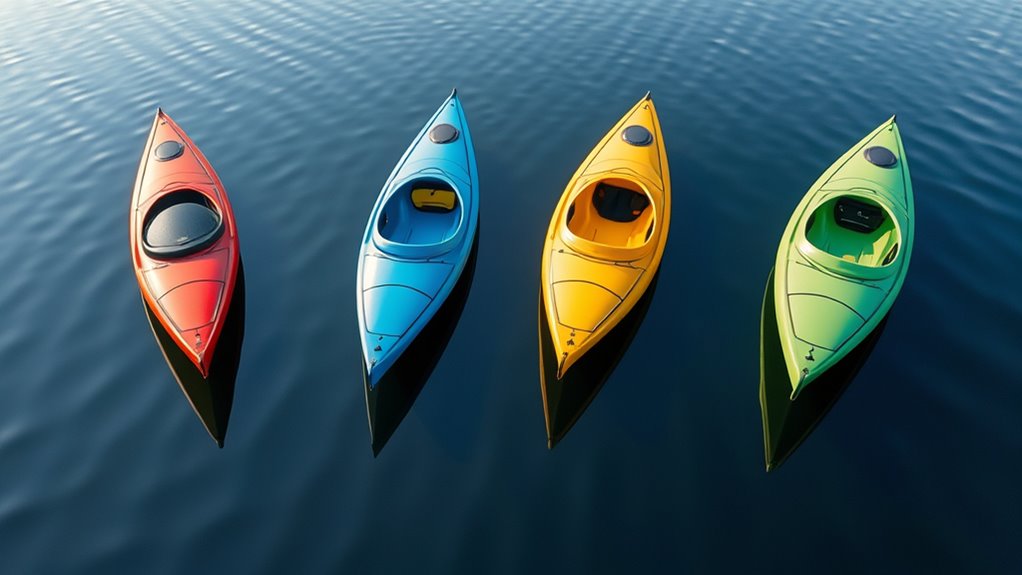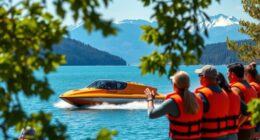Understanding kayak hull shapes can help you choose the right design for your paddling style. Wider, flatter hulls offer more stability in calm water, perfect for beginners, while narrow, V-shaped hulls excel in choppier conditions and for faster paddling. Flat-bottomed hulls are great on flat water, but V-shaped ones cut through rougher water more efficiently. If you want to learn how each shape impacts performance and stability, keep exploring the details behind these designs.
Key Takeaways
- Flat-bottomed hulls provide stability and smooth handling in calm waters but are less effective in choppy conditions.
- V-shaped hulls excel in rough water, offering better speed and cutting through choppy waves efficiently.
- Rounded hulls offer a versatile balance, suitable for varied water conditions and moderate stability.
- Hull shape influences maneuverability, with narrower V-shaped hulls offering sharper turns and flat hulls favoring stability.
- Water conditions and paddling goals should guide the choice of hull shape for optimal performance.

Choosing the right kayak hull shape can considerably impact your paddling experience, whether you’re fishing, touring, or racing. One of the key factors to consider is stability, which is influenced by the hull’s design. A wider, flatter hull provides greater initial stability, making it easier to balance and stay upright, especially if you’re new to kayaking or planning to stand while paddling. On the other hand, narrower, V-shaped hulls tend to offer better secondary stability, meaning they’re more stable once they’re slightly leaned over, which benefits experienced paddlers seeking agility and responsiveness. Understanding these stability considerations helps you pick a hull that matches your skill level and intended use, ensuring safe and enjoyable outings.
Choosing the right hull shape balances stability and agility for your skill level and paddling needs.
Material impacts also play an essential role in the performance and durability of your kayak hull. Most recreational kayaks are made from polyethylene, which is tough, affordable, and resistant to impacts, but tends to be heavier. This weight can affect maneuverability and transport, especially if you’re frequently launching from remote locations. Touring and racing kayaks often use lighter materials like fiberglass, carbon fiber, or composite shells. These materials reduce weight dramatically, improving speed and ease of handling, but generally come with a higher price tag and less impact resistance. If you plan to paddle in rough waters or rocky areas, a more durable material might be a better choice, even if it adds weight. Conversely, if you prioritize speed and ease of transport, lighter materials could be advantageous. Additionally, water conditions play a significant role in determining the best hull material and shape for your needs.
The hull shape also influences how a kayak interacts with different water conditions. Flat-bottomed hulls excel in calm, flat water and provide excellent stability, making them ideal for beginners or casual paddlers. V-shaped hulls cut through the water more efficiently, allowing for faster paddling and better performance in choppier conditions. Rounded hulls strike a balance, offering moderate stability and maneuverability, suitable for a variety of water types. When selecting a hull shape, think about where you’ll be paddling most often and your comfort with balancing stability versus speed and agility.
Ultimately, your choice of hull shape and material impacts how your kayak performs, feels, and lasts. Stability considerations should match your skill level and activity goals, while understanding material impacts ensures you pick a kayak that’s durable enough for your needs without sacrificing performance. By paying attention to these factors, you’ll find a hull shape that enhances your paddling experience and helps you enjoy every trip on the water.
Frequently Asked Questions
How Do Hull Shapes Affect Kayak Stability in Rough Water?
When paddling in rough water, hull shapes considerably influence your kayak’s stability. A wider hull offers greater buoyancy effects, helping it stay steady during waves, reducing the impact of wave impact and enhancing your confidence. Conversely, a narrower hull cuts through water more easily but may be less stable. Understanding these differences helps you choose a hull shape that balances maneuverability with stability, ensuring safer, more enjoyable paddling in challenging conditions.
Which Hull Type Is Best for Long-Distance Touring?
For long-distance touring, you want a hull design that offers efficiency and comfort. A pointed, streamlined hull reduces drag and helps you paddle longer with less effort. Consider materials like lightweight fiberglass or carbon fiber for durability and ease of transport. These choices enhance performance over extended trips, making your journey smoother. Ultimately, select a hull type that balances glide and stability, ensuring you enjoy your touring experience to the fullest.
Do Hull Shapes Influence Kayak Maneuverability Significantly?
You’ll find that hull shapes do influence kayak maneuverability quite a bit. A sleek, narrow hull offers better speed and agility, making turns easier, while broader hulls provide stability but may feel less responsive. Hull aesthetics and manufacturing techniques also play roles, impacting performance and handling. Understanding these factors helps you choose a kayak that matches your skill level and paddling style, ensuring a smoother, more controlled experience on the water.
How Does Hull Material Interact With Hull Shape Performance?
Imagine your kayak’s hull material is the secret ingredient that transforms its performance! The right material, like durable plastic or lightweight fiberglass, interacts with hull shape to maximize speed, stability, and maneuverability. It also influences material durability, ensuring your kayak withstands harsh conditions, and aesthetic appeal, keeping it sleek and attractive. Choosing the perfect combo means your kayak performs like a champion on the water while looking fantastic for years.
Are Certain Hull Shapes Better for Beginner Kayakers?
If you’re a beginner kayaker, certain hull shapes are better suited for your needs. Look for beginner-friendly designs that offer stability and ease of control, such as wider, flatter hulls. These novice kayak features help you feel confident on the water and reduce the chances of tipping. Choosing a hull shape focused on stability makes learning faster and more enjoyable, setting you up for successful kayaking adventures.
Conclusion
Now that you understand the different kayak hull shapes, you can choose with confidence. Whether you’re gliding smoothly through calm waters, slicing swiftly over choppy waves, or maneuvering sharply around tight corners, your hull shape influences every stroke. Embrace the power of the design that matches your style, and let each paddle stroke carry you farther, faster, and more comfortably. With the right hull, you’ll feel the thrill of the water, the freedom of the open lake, and the joy of every journey.










